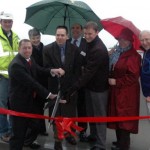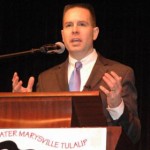Palmer and Kylee Zabel, WNPA Olympia News Bureau
Shortly after noon Wednesday, Jan. 16, Washington’s new governor Jay Inslee laid forth the vision for his first term that included focusing on job creation and preservation, a balanced operating budget, meeting the needs of the state’s education system, and an affordable health care system responsive to consumer needs.
Inslee delivered his inaugural address to a joint session of the legislature after being sworn in during a mid-morning ceremony in the Capitol rotunda.
Inslee views health care reform as a primary link to reaching a balanced budget and fully-funded education system.
“To honestly address our budget problems, we must admit the difficult truth that the road to a balanced budget and a fully funded educational system runs directly through health care reform,” he said. “This means investing in preventive care and aligning incentives with patients to encourage healthy lifestyle choices.”
In his speech, Governor Inslee stressed that Washington must stay innovative in order to remain competitive in a fast-changing world. Inslee, quoting former president and fellow Democrat Franklin D. Roosevelt, said “Never have we had so little time in which to do so much.”
Following the inaugural address, Republicans held a press briefing in response to comments made by the governor. Representative and House Minority Leader Richard DeBolt (R-20, Chehalis) applauded Inslee’s enthusiasm for innovation.
“We’ve got to be more innovative when it comes to reforming our government. We’ve got to live within our means,” he said.
Inslee stated that government, too, must also be agile and able to adapt to new circumstances. “I heard a clear and powerful message on election day. The people of Washington state are tired of a state government that doesn’t change with the times,” he said.
The governor said he wants government programs to be measured by their successes, rather than simply how much money is invested in them. Referring to taxpayers as “customers,” Inslee said that the cycle of old, uncompromising ideas are unproductive, and that his administration is dedicated to “a multi-year effort to bring disruptive change to Olympia, starting with the very core of how we do business. If we’re serious about long term economic growth, innovation must become part of the very culture of Olympia.”
Senator Andy Hill (R-45, Redmond) was impressed by Inslee’s pledge to measure the success of programs by their results, not the dollars spent. But Republicans suggested that the governor’s speech was lacking in specifics.
Inslee emphasized that job creation will be his top priority while in office, a point with which Republicans said they completely agreed.
“Our priorities from day one have been consistent. Jobs, education and a sustainable budget,” said Schoesler.
And those three priorities are linked, said Representative Gary Alexander (R-2, Olympia), by helping the people of Washington to have faith in the legislative process. “If we can provide trust and a way to control our budget and be in control of our resources, the same way they do, then they will also have faith…to expand their resources,” said Alexander.
The governor singled out clean energy, such as solar and wind power, as a growth industry in Washington, one that he believes could help the state work toward sustainability in economic growth and stewardship of the environment.
“The key is affordable energy,” said Schoesler responding to the governor’s energy citation. “For that struggling family out there, the cost of energy is critical. Businesses locate to parts of Washington because of some of the most affordable energy in the United States. Keeping that energy affordable is very important to the state of Washington. If we look at our first priority of jobs, affordable energy is a big part of that.”
Inslee reiterated his support for education in the wake of the McCleary decision by the state Supreme Court, which instructed government to fund the basic education system before anything else. “I am proud to live in a state where the education of our children is enshrined as the paramount duty of state government.”
Science, technology, education and math curriculum, said Inslee, are a must for all levels of education. “They are the essential tools for success in this new economy,” he said.
The House Republican Caucus has put forth statements that it will submit a proposal to the legislature to create a separate basic education budget that would require adoption prior to any other budget negotiations each biennium.
“It’s not just funding education first, it’s funding it fully. And we intend to do that with the first K-12 budget,” said Alexander. “This sends a message to the Supreme Court that we are on a very sustainable path.”
Representative and Minority Caucus Chair Dan Kristiansen (R-39, Snohomish) explained that education has directly affected unemployment in the state. “If we’re going to pay for all these things, let’s face it, we need tax dollars,” said Kristiansen, “which means we need people working again.”
Health care reform may be a way to both save money and improve lives, Inslee said. Implementing the federal Affordable Care Act, including expansion of preventive care and encouraging citizens to lead healthy lifestyles, he said, will help the system “move from ‘sick care’ to the true health care system we deserve.”
Inslee cited mental-health care as an important part of preventing gun violence such as the recent shootings at Sandy Hook Elementary School in Connecticut, Café Racer in Seattle, the murder of four police officers in Lakewood and the shooting at the Seattle Jewish Federation in 2006.
The governor urged cooperation and compromise in solving the problem of gun violence. “I don’t have all the answers, but I know the sooner we reject the extremes and embrace common sense, the sooner we’ll be able to get a public health solution to this public health problem.”
According to DeBolt, the members of the House Republican Caucus have met with the Washington Education Association (WEA) and the caucus has put together a task force in order to address mental health issues in the wake of these recent tragedies.
“Keeping our children and our teachers safe is one of our paramount duties,” said DeBolt. “We are willing to work with Jay Inslee, House Speaker Chopp, Senate coalition leader Rodney Tom, all of the people that need to be worked with to find a solution.”
In closing Inslee said, “I look forward to having a real dialogue with the Legislature in the coming weeks on how we best put our ingenuity to work to meet the challenges before us — on creating jobs, educating our children, changing how we do business in state government and creating a culture of leading the world in energy independence. Now let’s get to work.”














